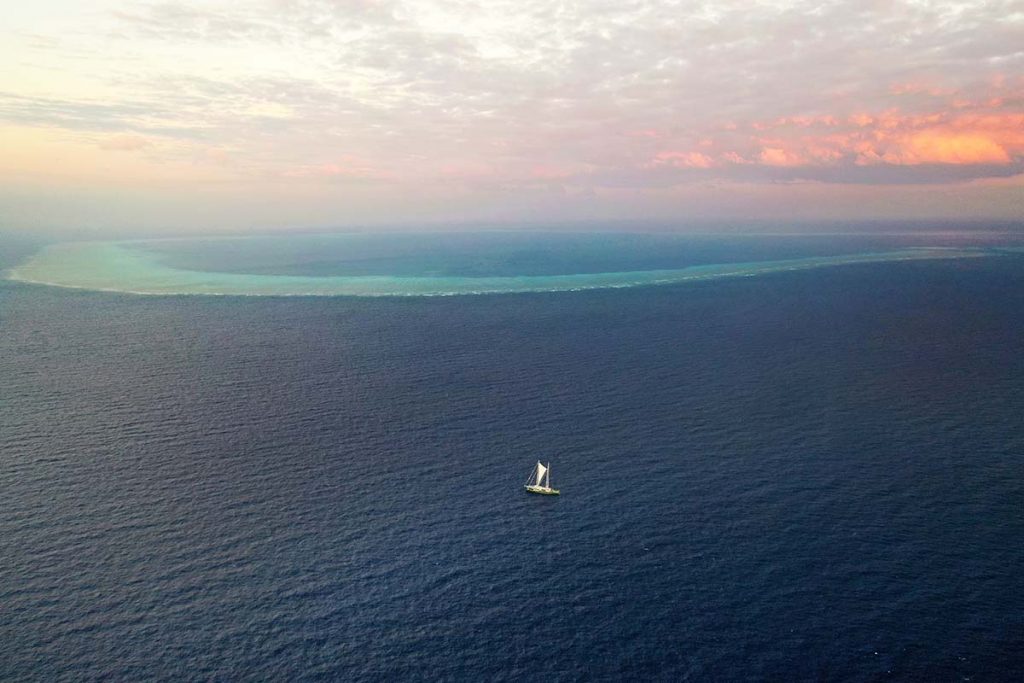
Aerial view of North Scott Reef. In this photo the Rainbow Warrior depicts the approximate location where Woodside intends to drill for gas for its Browse project. This location has been determined using GPS coordinates provided by Woodside in its Environmental Impact Statement (EIS).
Millions of years ago, a massive barrier reef – as big as the Great Barrier Reef – stretched along the coast of what is now northern WA. Over time the reef retreated. Now all that remains is a series of isolated atolls Ashmore Reef, Seringapatam and Scott Reef, and the Rowley Shoals.

Stunning shots of Scott and Seringapatam Reefs, far off the Western Australia Coastline.
You might not have heard much about Scott Reef, but it’s a pretty special place. Scott Reef consists of two formations, North Scott Reef and horseshoe-shaped South Reef. This oceanic reef system includes a third formation – Seringapatam Reef – which is about 30km to the north east of Scott Reef.

This is an image of Seringapatam Reef, part of the same reef system as Scott Reef, and the Rainbow Warrior
We were lucky enough to visit the Scott Reef system in May 2023 when the Rainbow Warrior toured Western Australia. The waters surrounding the three reefs are teeming with life. There are at least 29 species of marine mammals; 41 species of birds; almost 1,000 species of fish; sharks, sea snakes, rays, sawfish and many more amazing and unique animals – some of which haven’t been found anywhere else.

Corals in Scott Reef

Sea snake near Scott Reef
Scott Reef is a critical spot for endangered pygmy blue whales (EPBC Act). Each autumn, thousands of whales migrate up the coast of Western Australia, traveling from the cool waters of southern Australia to the tropics. In spring, they migrate south again, spending the summer in Tasmania, Victoria and southern Western Australia before swimming north again.

Pygmy blue whales in WA
The whales’ migration path takes them right past Scott Reef. Although we don’t know for sure, many whale experts believe that Scott Reef is an aquatic Driver Reviver – a place for pygmy blue whales (and other migratory species) to stop and feed before continuing their journey.

Green turtles in Scott Reef
Nestled in between North and South Scott Reef is Sandy Islet – a tiny spit of sand where up to a thousand endangered (IUCN; vulnerable – EPBC Act) green sea turtles lay their eggs every year. Adult sea turtles are migratory and swim up to thousands of kilometres to get here.

Turtle nesting on Sandy Islet at Scott Reef
Females nesting near Sandy Islet are highly dependent on the food-rich waters around Scott Reef to sustain them during this exhausting period. A few months later, the newly hatched green turtles make their way to the ocean and the cycle begins again.

Image showing the approximate location where Woodside intends to drill for gas for its Browse project. This location has been determined using GPS coordinates provided by Woodside in its Environmental Impact Statement (EIS)
Like all coral reefs, Scott Reef is threatened by rising sea levels and warming oceans caused by climate change. Yet it faces an additional threat: fossil fuel giant Woodside. Browse, Australia’s largest untapped conventional gas reserve, lies directly underneath Scott Reef.
Woodside wants to drill up to 50 wells to develop Browse – and pump the gas buried deep under the reef hundreds of kilometres to shore to be processed and exported overseas.

Woodside drilling an exploration well at Scott Reef. © Woodside Energy
Woodside’s dirty gas could be a disaster for Scott Reef and the wildlife that depends upon it. It would turn this pristine reef and surrounding waters into an industrial gas zone blighted by seismic blasting, gas flaring, drilling and pipelaying.
The climate change produced by Woodside’s dirty gas would contribute to ocean warming, which causes coral bleaching and seriously harms marine life. And if one of Woodside’s wells suffered a blowout – well, the consequences of a worst-case spill here are unthinkable.
Thankfully, there’s still time to stop Woodside. Federal Environment Minister, Tanya Plibersek, will soon be reviewing Woodside’s plans. Contact your MP today and let them know that you want Scott Reef protected from Woodside and its dirty gas.
P.S. It has come to our attention that previously Greenpeace has inadvertently used an image of an adjacent reef to depict Scott Reef. The correct image is used above (Image 1). Greenpeace apologises for any confusion caused.


